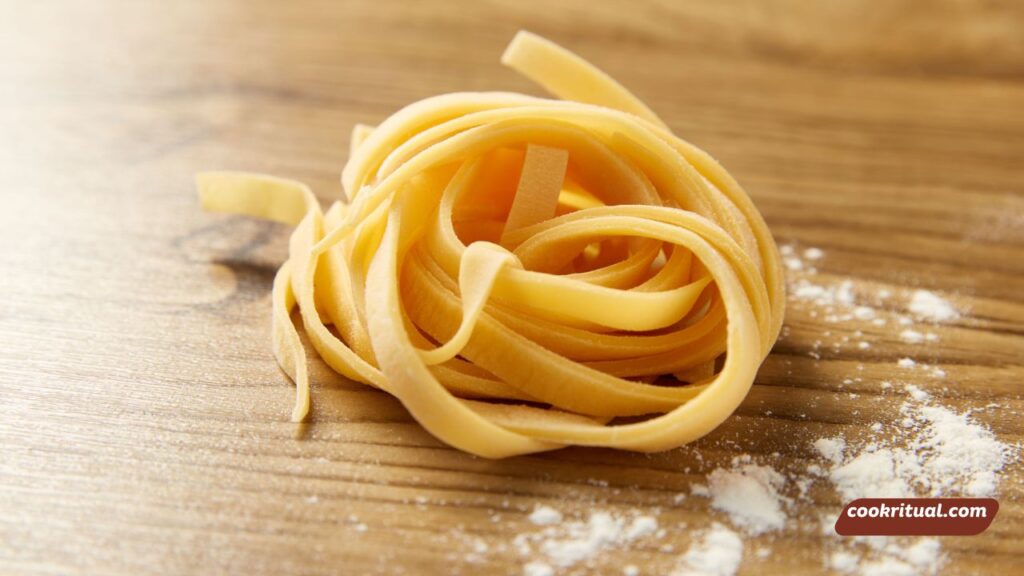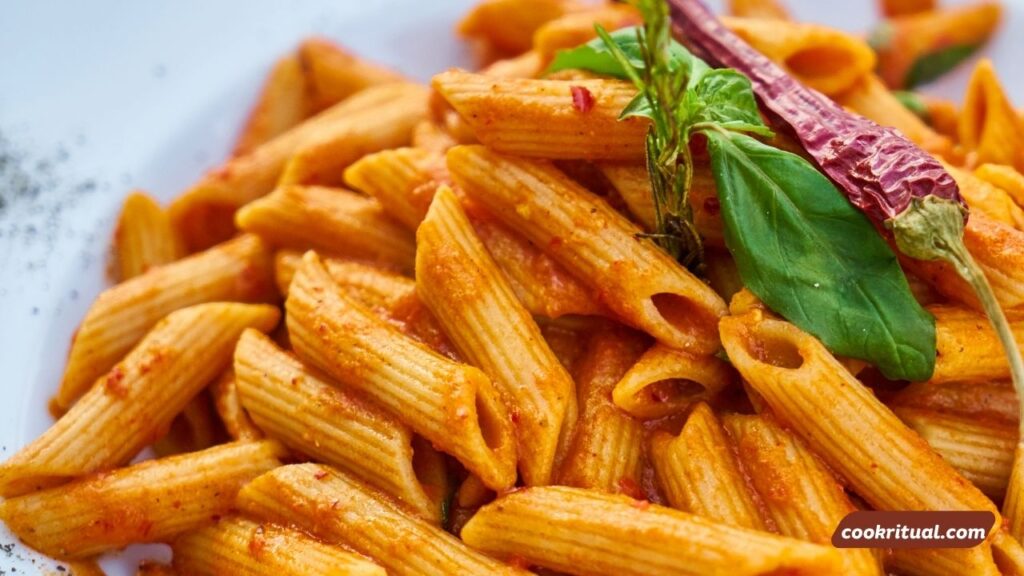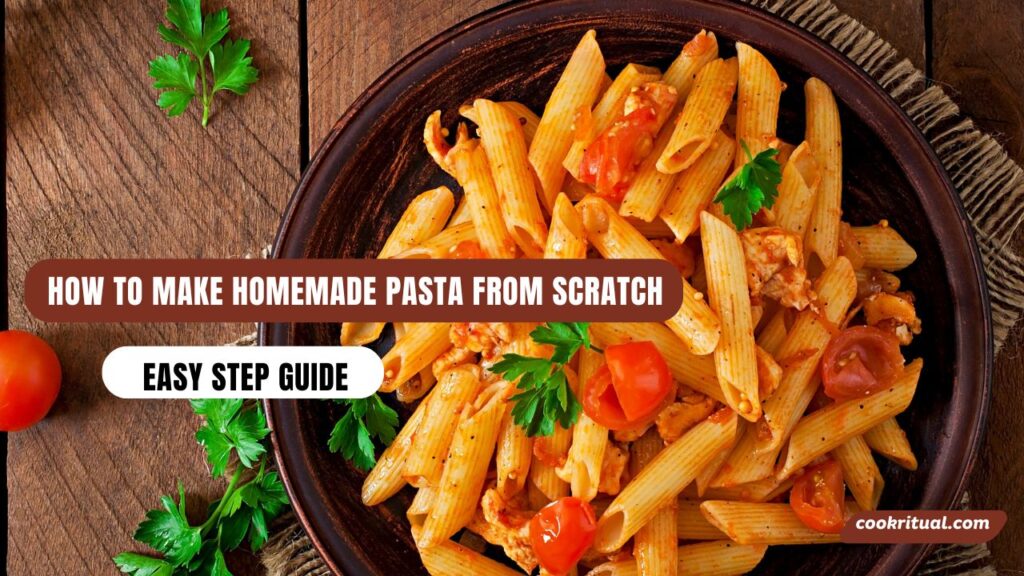Yes, anyone can make homemade pasta from scratch—even without a pasta machine. All it takes is a handful of fresh ingredients, a flat surface, and a little patience. The reward? Silky, chewy, tender pasta that beats anything store-bought. Whether we’re craving classic spaghetti, wide ribbons of fettuccine, or delicate cheese ravioli, homemade pasta gives us complete control over flavor, texture, and nutrition.
For health-conscious cooks and busy professionals alike, pasta from scratch is more than just a recipe—it’s a satisfying ritual. It allows us to skip preservatives, adjust ingredients for dietary needs, and even meal prep for the week ahead. With a few simple tools and our friendly step-by-step method, we’ll be rolling out dough like nonna in no time.
In this guide, we’ll walk through the why, what, and how of making pasta by hand. From selecting the right flour to cutting and cooking perfect noodles, this evergreen guide will equip any home cook with the skills (and confidence) to make pasta that’s nutritious, delicious, and deeply satisfying.
Contents
- 1 Why Make Homemade Pasta?
- 2 What You’ll Need – Essential Ingredients and Tools
- 3 Step-by-Step Guide to Making Homemade Pasta Dough
- 4 Cooking Homemade Pasta – Tips for Perfect Texture
- 5 Common Pasta Dough Variations to Try
- 6 Drying, Storing, and Freezing Homemade Pasta
- 7 Homemade Pasta Recipes to Try Next
- 8 Troubleshooting: Common Pasta-Making Mistakes and Fixes
- 9 Tools Comparison: Pasta Maker vs Rolling Pin
- 10 FAQs – Everything You’re Wondering About Homemade Pasta
- 11 Buying Guide: Best Products for Homemade Pasta Making
- 12 Final Tips and Next Steps
- 13 Conclusion
Why Make Homemade Pasta?

The Benefits of Fresh Pasta Over Store-Bought
Fresh pasta tastes better—plain and simple. It has a soft, smooth texture and a rich, eggy flavor that’s hard to find in dried boxed noodles. We also get to control the ingredients and skip the preservatives. Fresh pasta cooks faster and absorbs sauces more easily, which makes every bite more flavorful.
It’s also more versatile. We can make it thick or thin, short or long, stuffed or plain. And when we make it ourselves, we know exactly what’s going in—nothing extra, just fresh, wholesome food.
Nutritional and Ingredient Control
Homemade pasta gives us power over nutrition. Want more fiber? Use whole wheat flour. Need lower carbs? Try mixing in almond flour. Want more protein? Add an extra egg yolk. For anyone with food sensitivities or those following a clean eating lifestyle, that’s a huge win.
We can even make gluten-free pasta using blends like rice flour, tapioca, or certified gluten-free all-purpose flour. For trusted guidance on safe flour choices, the Celiac Disease Foundation is a great resource.
A Fun and Rewarding Cooking Experience
Making pasta is like kitchen therapy. Kneading dough by hand helps us slow down and enjoy the process. It’s also a great way to involve kids, friends, or a partner in a hands-on activity.
It’s more than cooking—it’s creating. And when we roll out our first sheet of pasta, there’s something deeply satisfying about it. Plus, once we get the hang of it, we can prep batches in advance for quick weeknight meals.
What You’ll Need – Essential Ingredients and Tools
Key Pasta Dough Ingredients
Making fresh pasta starts with just a few simple ingredients. Here’s what we need:
- Flour – All-purpose is fine, but semolina flour adds structure and texture.
- Eggs – Whole eggs give the dough richness and color.
- Salt – Just a pinch for flavor.
- Olive oil (optional) – Adds a smoother texture and a hint of flavor.
We can also add water as needed to adjust the dough’s moisture.
Tools for Making Pasta from Scratch
No fancy tools required—but a few basics help:
| Tool | Purpose |
| Mixing bowl | For combining ingredients |
| Fork or hands | To mix the dough |
| Rolling pin | To flatten the dough |
| Knife or pasta cutter | To shape the pasta |
| Pasta machine (optional) | Speeds up rolling and shaping |
| Pasta drying rack (optional) | Helps prevent clumping while drying |
If we’re just getting started, we can easily use what we already have at home.
Optional Add-Ins for Flavor and Color
Want to get creative? Try adding:
- Spinach or basil purée for green pasta
- Beet juice for red pasta
- Squid ink for a dramatic black look
- Chili flakes or herbs for an extra kick
These add-ins bring color and personality, without changing the basic process.
Step-by-Step Guide to Making Homemade Pasta Dough
Step 1: Measure and Mix the Ingredients
On a clean surface or in a mixing bowl, we combine 2 cups of flour with a pinch of salt. Make a well in the center, then crack in 3 large eggs. We use a fork to slowly beat the eggs and pull in flour from the sides.
Once it’s thick, we switch to our hands and begin forming a shaggy dough.
Step 2: Knead the Pasta Dough by Hand
We knead the dough for about 8–10 minutes. It should feel smooth, firm, and elastic—not sticky or too dry. If needed, add a teaspoon of water or a dusting of flour to adjust.
Kneading builds gluten, which gives the pasta its chew. For tips on proper kneading, King Arthur Baking offers great visuals.
Step 3: Let the Dough Rest (Why It’s Important)
Wrap the dough in plastic wrap and let it rest for 30 minutes at room temperature. This relaxes the gluten and makes rolling easier.
If we’re not using it right away, we can refrigerate it for up to 24 hours.
Step 4: Roll Out the Dough (By Hand or Machine)
Cut the rested dough into smaller sections. Flatten one piece slightly, then roll it out with a pin or run it through a pasta machine. Keep flour nearby to prevent sticking.
Roll until it’s thin—about the thickness of a dime. For stuffed pasta like ravioli, go even thinner.
Step 5: Cut Into Desired Shapes (Spaghetti, Fettuccine, Ravioli)
Once the dough is rolled, we can cut it into strips, sheets, or circles depending on the pasta style. A knife works well for rustic shapes. Pasta cutters give cleaner lines. If we’re using a machine, most come with spaghetti and fettuccine cutters built in.
Dust cut pasta with flour and let it dry slightly while we prepare to cook.
Cooking Homemade Pasta – Tips for Perfect Texture
How Long to Cook Fresh Pasta
Fresh pasta cooks much faster than dried. Most shapes are done in just 2 to 4 minutes in boiling salted water. We know it’s ready when it floats and feels tender but firm to the bite—what Italians call al dente.
We recommend checking early and tasting often. Overcooking fresh pasta can make it mushy. For a guide to safe cooking temperatures and timing, visit the USDA’s kitchen safety page.
Cooking Tips for Different Pasta Shapes
Different pasta types need slight adjustments. Thin noodles like angel hair need only 90 seconds. Thicker cuts like pappardelle or stuffed ravioli may take closer to 4 minutes.
Quick Tips:
- Stir gently to prevent sticking
- Use lots of water—about 4 quarts per pound
- Salt the water like the sea for best flavor
- Don’t add oil—it prevents sauce from sticking
Seasoning the Water and Saucing Suggestions
We always salt our pasta water—about 1 tablespoon per 4 quarts. This is our only chance to flavor the pasta itself.
Fresh pasta shines with simple sauces. Try:
- Olive oil with garlic and herbs
- A light tomato basil sauce
- Brown butter and sage
- Lemon zest and Parmesan
For low-sodium or heart-healthy sauce ideas, check American Heart Association recipes.
Common Pasta Dough Variations to Try

Egg Pasta Dough vs Eggless
Classic pasta uses eggs for richness and structure. But for lighter or vegan-friendly dough, we can skip the eggs and add a little water and olive oil instead. Eggless dough works best for short pasta shapes like orecchiette or trofie.
Using Semolina Flour vs All-Purpose Flour
Flour choice changes texture. Here’s a simple comparison:
| Flour Type | Texture | Best For |
| Semolina | Firm and chewy | Cut pasta like spaghetti, fettuccine |
| All-purpose | Soft and tender | Stuffed pasta like ravioli |
| 00 Flour | Silky smooth | Sheets for lasagna or delicate noodles |
Bob’s Red Mill and King Arthur Baking both offer excellent quality flours for pasta making.
Whole Wheat and Gluten-Free Options
Whole wheat flour adds fiber and a nutty flavor. We can replace up to 50% of white flour without major changes. For gluten-free versions, we suggest blends that include rice flour, xanthan gum, and potato starch.
For more on gluten-free cooking, visit Mayo Clinic’s Celiac Disease Guide.
Drying, Storing, and Freezing Homemade Pasta
How to Air-Dry Fresh Pasta
If we’re not cooking it right away, drying is a great option. Hang noodles over a drying rack or a clean broomstick. For short shapes, lay them on a floured tray.
Let pasta dry for 12–24 hours in a cool, dry space. Once fully dry, store it in an airtight container.
Refrigerating and Freezing Tips
Fresh pasta can be stored in the fridge for up to 2 days. To freeze, lay the cut pasta in small nests on a baking sheet. Freeze for an hour, then transfer to bags or containers.
Frozen pasta lasts up to 2–3 months and cooks straight from frozen—just add 1–2 extra minutes of boiling time.
Best Storage Containers for Homemade Pasta
Here’s a quick look at ideal storage options:
| Storage Method | Container Type | Shelf Life |
| Dry pasta | Airtight glass or plastic | 1–2 months |
| Fresh (refrigerated) | Sealed container | Up to 2 days |
| Frozen | Freezer-safe bag or box | 2–3 months |
Look for BPA-free containers like Rubbermaid Brilliance or vacuum-sealed options for longer freshness.
Homemade Pasta Recipes to Try Next
Classic Homemade Spaghetti
A timeless favorite. Pair with tomato basil sauce or garlic and olive oil.
Fresh Fettuccine with Alfredo Sauce
Silky ribbons coated in creamy Parmesan sauce—perfect for cozy nights.
Easy Cheese Ravioli from Scratch
Stuffed with ricotta, Parmesan, and herbs. Great for freezing ahead.
Spinach Pasta Dough Recipe
Blend spinach into the eggs for a green twist with extra nutrients. A fun way to add veggies.
For all these recipes, refer to our Healthy Pasta Recipe Hub (link placeholder) for ingredients and detailed steps.
Troubleshooting: Common Pasta-Making Mistakes and Fixes
Dough Too Dry or Too Sticky
If dough feels dry, add a teaspoon of water. If sticky, dust with flour. The goal is smooth but not tacky.
Uneven Pasta Thickness
Always roll from the center outward. Fold and roll again if needed. A pasta machine helps ensure uniform thickness.
Pasta Clumping During Cooking
Toss noodles in flour before storing or cooking. Stir them early in the pot to prevent sticking.
Tools Comparison: Pasta Maker vs Rolling Pin
Manual vs Electric Pasta Machines
Manual machines are budget-friendly and give full control. Electric machines save time and effort, great for frequent cooks.
Best Pasta Rollers for Beginners
Look for ones with adjustable settings and clamp-on bases. Brands like Marcato and KitchenAid are trusted.
Pros and Cons of Hand-Rolling Pasta
Hand-rolling gives rustic charm and requires no special gear. It takes more time and muscle but is great for flat or thick pasta styles.
FAQs – Everything You’re Wondering About Homemade Pasta
Can I make pasta dough ahead of time?
Yes, wrap and refrigerate it for up to a day. Let it come to room temp before rolling.
What flour is best for pasta dough?
All-purpose is great for beginners. Semolina adds chew. Try 00 flour for ultra-smooth sheets.
How do I keep pasta from sticking together?
Dust with flour, shake off excess, and use plenty of boiling water with stirring.
Can I freeze pasta dough?
Yes. Wrap tightly in plastic, then freeze. Thaw in the fridge overnight before using.
Do I need a pasta machine?
Not at all. A rolling pin and sharp knife will do just fine. Machines simply speed things up.
Buying Guide: Best Products for Homemade Pasta Making
Recommended Pasta Makers for Home Use
Top picks include the Marcato Atlas 150 and KitchenAid Pasta Attachments. Look for machines with multiple settings and durable parts.
Flour Brands for High-Quality Pasta Dough
We love King Arthur, Bob’s Red Mill, and Central Milling for consistent quality.
Tools That Make Pasta Making Easier (Cutters, Dryers, Racks)
A pasta cutter wheel, drying rack, and nesting trays help speed up the process and reduce waste. Budget-friendly kits are widely available online or at stores like Sur La Table.
Final Tips and Next Steps
Start Simple: Try Basic Spaghetti First
Spaghetti is easy to roll and cut. Once we master it, we can explore more shapes and flavors.
Practice Makes Perfect: Don’t Fear Imperfections
No one gets it perfect the first time. That’s part of the fun. With every batch, we learn a little more.
Invite Friends or Kids for a Pasta Night
Making pasta together is a joy. It turns dinner into a memory. Everyone can help roll, cut, or cook.
Conclusion
Homemade pasta may sound fancy, but it’s truly simple, satisfying, and full of flavor. With just a few ingredients and some practice, we can create pasta that’s healthier, tastier, and more personal than anything from a box.


